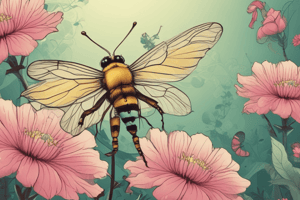Podcast
Questions and Answers
What is the advantage of cleistogamous flowers?
What is the advantage of cleistogamous flowers?
- They require pollinators for seed production
- They are less attractive to pollinators
- They produce assured seed-set even in the absence of pollinators (correct)
- They produce fewer seeds compared to open flowers
In geitonogamy, the pollen grains are transferred from:
In geitonogamy, the pollen grains are transferred from:
- The anther to the stigma of a different species
- The anther to the stigma of the same flower
- The anther to the stigma of another flower on the same plant (correct)
- The anther to the stigma of a different plant
Which type of pollination brings genetically different pollen grains to the stigma?
Which type of pollination brings genetically different pollen grains to the stigma?
- Autogamy
- Xenogamy (correct)
- Cleistogamy
- Geitonogamy
Which of the following is an abiotic agent of pollination?
Which of the following is an abiotic agent of pollination?
Why do flowers produce an enormous amount of pollen compared to the number of ovules available for pollination?
Why do flowers produce an enormous amount of pollen compared to the number of ovules available for pollination?
Which of the following agents of pollination is biotic?
Which of the following agents of pollination is biotic?
What is the mechanism that allows flowering plants to achieve successful reproduction?
What is the mechanism that allows flowering plants to achieve successful reproduction?
Which of the following statements about autogamy is true?
Which of the following statements about autogamy is true?
Which of the following types of flowers are invariably autogamous?
Which of the following types of flowers are invariably autogamous?
What is the term used to describe the transfer of pollen grains from the anther to the stigma?
What is the term used to describe the transfer of pollen grains from the anther to the stigma?
Which of the following plants produce both chasmogamous and cleistogamous flowers?
Which of the following plants produce both chasmogamous and cleistogamous flowers?
What is the main purpose of pollination in flowering plants?
What is the main purpose of pollination in flowering plants?
Flashcards are hidden until you start studying




